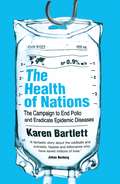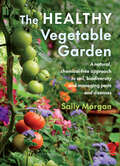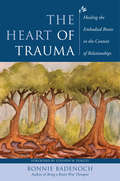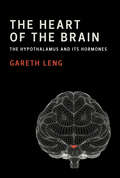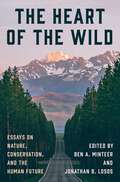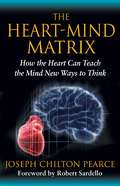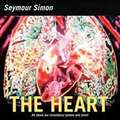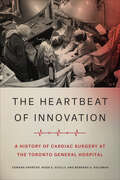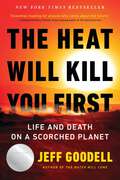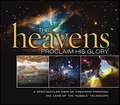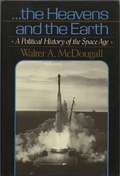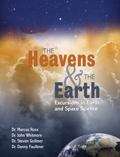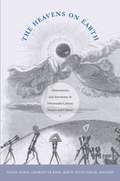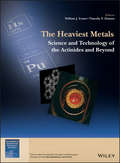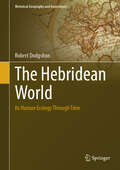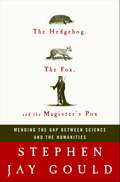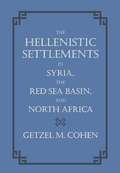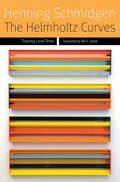- Table View
- List View
The Health of Nations: The Campaign to End Polio and Eradicate Epidemic Diseases
by Karen Bartlett&‘Hope lies in dreams, in imagination, and in the courage of those who dare to make dreams into reality.&’ – Jonas Salk, inventor of one of the first successful polio vaccines No one will die of smallpox again… One of the worst killers ever is now consigned to history – perhaps the greatest humanitarian achievement of our age. Now polio, malaria and measles are on the hit list. Karen Bartlett tells the dramatic story of the history of eradication and takes us to the heart of modern campaigns. From high-tech labs in America to the poorest corners of Africa and the Middle East, we see the tremendous challenges those on the front lines face every day, and how they take us closer to a brave new world.
The Healthy Vegetable Garden: A natural, chemical-free approach to soil, biodiversity and managing pests and diseases
by Sally MorganWhether you’re an experienced gardener, homesteader, or market farmer, this A–Z, soil-to-table guide shows you how to reduce chemical inputs; naturally enrich your growing ecology; and create a hardy, nutrient-dense, and delicious crop. "There are few gardeners (or farmers) I know who wouldn’t benefit from reading Sally Morgan’s new book. . . . The Healthy Vegetable Garden is a detailed and indispensable resource."—Hobby Farms In The Healthy Vegetable Garden, expert organic gardener Sally Morgan explains how to use natural approaches to cope with the challenges of a changing climate through principles from regenerative gardening, agroecology, and permaculture—all to help your green space thrive. The Healthy Vegetable Garden shows you how to: Combat disease and keep pests at bay with natural predators, companion planting, and trap and barrier crops Choose the right plants to attract pollinators and pest predators Build a healthy soil full of organic matter, earthworms, and mycorrhizal fungi Regenerate soil through no-dig practices, composting, cover crops, and mulching Boost biodiversity through the use of crop rotations and polyculture Rewild your garden by creating a range of habitats, making use of walls and fences, log piles, water features, and wild corners Understand plant defenses and use biocontrols Make natural barriers, traps, and lures A healthy, productive garden should work in harmony with nature to produce and protect delicious fruits and vegetables and build a rich soil that is full of life. With The Healthy Vegetable Garden, growers of all levels will start reducing incidents of pests and diseases while creating a verdant habitat—all without the need for fertilizers, pesticides, or weedkillers.
The Heart of Trauma: Healing The Embodied Brain In The Context Of Relationships (Norton Series on Interpersonal Neurobiology #0)
by Bonnie Badenoch Stephen W. PorgesHow each of us can become a therapeutic presence in the world. Images and sounds of war, natural disasters, and human-made devastation explicitly surround us and implicitly leave their imprint in our muscles, our belly and heart, our nervous systems, and the brains in our skulls. We each experience more digital data than we are capable of processing in a day, and this is leading to a loss of empathy and human contact. This loss of leisurely, sustained, face-to-face connection is making true presence a rare experience for many of us, and is neurally ingraining fast pace and split attention as the norm. Yet despite all of this, the ability to offer the safe sanctuary of presence is central to effective clinical treatment of trauma and indeed to all of therapeutic practice. It is our challenge to remain present within our culture, Badenoch argues, no matter how difficult this might be. She makes the case that we are built to seek out, enter, and sustain warm relationships, all this connection will allow us to support the emergence of a humane world. In this book, Bonnie Badenoch, a gifted translator of neuroscientific concepts into human terms, offers readers brain- and body-based insights into how we can form deep relational encounters with our clients and our selves and how relational neuroscience can teach us about the astonishing ways we are interwoven with one another. How we walk about in our daily lives will touch everyone, often below the level of conscious awareness. The first part of The Heart of Trauma provides readers with an extended understanding of the ways in which our physical bodies are implicated in our conscious and non-conscious experience. Badenoch then delves even deeper into the clinical implications of moving through the world. She presents a strong, scientifically grounded case for doing the work of opening to hemispheric balance and relational deepening.
The Heart of the Brain: The Hypothalamus and Its Hormones (The\mit Press Ser.)
by Gareth LengHow hormonal signals in one small structure of the brain—the hypothalamus—govern our physiology and behavior.As human beings, we prefer to think of ourselves as reasonable. But how much of what we do is really governed by reason? In this book, Gareth Leng considers the extent to which one small structure of the neuroendocrine brain—the hypothalamus—influences what we do, how we love, and who we are.The hypothalamus contains a large variety of neurons. These communicate not only through neurotransmitters, but also through peptide signals that act as hormones within the brain. While neurotransmitter signals tend to be ephemeral and confined by anatomical connectivity, the hormone signals that hypothalamic neurons generate are potent, wide-reaching, and long-lasting. Leng explores the evolutionary origins of these remarkable neurons, and where the receptors for their hormone signals are found in the brain. By asking how the hypothalamic neurons and their receptors are regulated, he explores how the hypothalamus links our passions with our reason. The Heart of the Brain shows in an accessible way how this very small structure is very much at the heart of what makes us human.
The Heart of the Wild: Essays on Nature, Conservation, and the Human Future
by Gary Paul Nabhan Peter H. Raven Joel Berger Harry W. Greene Hal Herzog Susan Clayton Emma Marris Kathleen Dean Moore Thomas Lowe Fleischner Eileen Crist Bill Adams Martha L. Crump Christopher J. Schell Richard Shine Kyle WhyteTimely and provocative reflections on the future of the wild in an increasingly human worldThe Heart of the Wild brings together some of today&’s leading scientists, humanists, and nature writers to offer a thought-provoking meditation on the urgency of learning about and experiencing our wild places in an age of rapidly expanding human impacts.These engaging essays present nuanced and often surprising perspectives on the meaning and value of &“wildness&” amid the realities of the Anthropocene. They consider the trends and forces—from the cultural and conceptual to the ecological and technological—that are transforming our relationship with the natural world and sometimes seem only to be pulling us farther away from wild places and species with each passing day. The contributors make impassioned defenses of naturalism, natural history, and nature education in helping us to rediscover a love for the wild at a time when our connections with it have frayed or been lost altogether.Charting a new path forward in an era of ecological uncertainty, The Heart of the Wild reframes our understanding of nature and our responsibility to learn from and sustain it as the human footprint sinks ever deeper into the landscapes around us.With contributions by Bill Adams, Joel Berger, Susan Clayton, Eileen Crist, Martha L. Crump, Thomas Lowe Fleischner, Harry W. Greene, Hal Herzog, Jonathan B. Losos, Emma Marris, Ben A. Minteer, Kathleen Dean Moore, Gary Paul Nabhan, Peter H. Raven, Christopher J. Schell, Richard Shine, and Kyle Whyte.
The Heart-Mind Matrix: How the Heart Can Teach the Mind New Ways to Think
by Joseph Chilton Pearce Robert SardelloActivating the compassionate intelligence of the heart to reconnect to the universe and our spiritual future • Shows how the heart is connected to our prefrontal cortex and offers a balancing counterweight to the calculating intellect of the lower brain • Explains how we are stuck in reactive behavior loops resulting from the loss of the nurturing culture of our ancestors • Reveals how the Heart-Mind Matrix connects us to the universe and is the engine of spiritual evolution Expanding the revolutionary theories of mind explored in the bestselling The Crack in the Cosmic Egg and The Biology of Transcendence, Joseph Chilton Pearce explains how the heart provides the balancing intelligence to the brain’s calculating intellect, an innate system of emotional-mental coherence lost generations ago through a breakdown of the nurturing culture of our ancestors. By severing ourselves from our heart intelligence, we are left with our selfish, survival-oriented reptilian brains, which create and reinforce “strange loops” between potential and actual reality, leading to our modern world’s endless cycle of self-inflicted disasters and societal crises. Pearce explains that in order to break these cycles and transcend a life focused solely on surviving the results of our own reactive patterns, we must reconnect with the compassionate intelligence of the heart. Offering a rich variety of evidence, Pearce explores neurological research, lost and enduring nurturing cultures, personal experiences, and accounts from the lives and writings of modern sages such as Jane Goodall, Maria Montessori, and Rudolf Steiner. He shows that by activating the original matrix of the Heart-Mind--the engine of our spiritual evolution and our innate connection to the universe--we can teach our brains new ways to think, amend our destructive behavior loops, and enter into a future of peace, spiritual connection, and conscious evolution.
The Heart: Our Circulatory System
by Seymour SimonYou know your heart beats, but did you know it beats over two billion times in a lifetime? You know you have veins, but did you know that the upper vena cava is as wide as a pencil and brings blood from your brain and upper body back to your heart? You know blood flows, but did you know your veins have valves like parachutes that open and close to keep blood from flowing backwards? You know you have red blood cells, but did you know that if they were stacked on top of each other they'd make a column thirty thousand miles high? Blood flows through arteries and veins. Do you know the difference between them? Discover what jobs the white and red blood cells do to keep you alive. Learn the parts of your heart and the blood vessels that let your blood flow to every part of your body. You'll learn new, big words like: septum, hemoglobin, atria, valve, ventricles, plasma, cells, pulmonary, veins, arteries, marrow, venules, alveoli, neutrophils, capillaries, sinoatrial node, and upper and lower vena cava. Find how a muscle the size of a large sweet potato keeps you alive. You'll be interested and learning as you read and you'll become smart about your heart. Read other books by this author from Bookshare including The Brain, Mars, Muscles and Bones.
The Heart: Our Circulatory System (Updated Edition)
by Seymour SimonDescribes the heart, blood, and other parts of the body's circulatory system and explains how each component functions.
The Heartbeat of Innovation: A History of Cardiac Surgery at the Toronto General Hospital
by Edward Shorter Hugh E. Scully Bernard S. GoldmanGreat innovations take place within great institutions. Founded in 1819, Toronto General Hospital (TGH) is one of Canada’s oldest hospitals and has created a nurturing environment for early Canadian innovations in heart surgery. The Heartbeat of Innovation tells the story of the brilliant surgeons who worked there and the hospital environment that provided an incubator to the many people – skilled perfusionists, dedicated nurses, and pioneering cardiologists – who participated in the revolution in heart surgery that took place along University Avenue in Toronto. Supported by historical records, hospital archives, personal memoirs, and interviews, this book is an extensive and descriptive account of the seemingly inexorable development of cardiac surgery at this leading academic health science centre. It pursues several themes: the complexity of this surgical specialty, its generally male-dominated nature, the trend toward teamwork in practice, and the evolution and incorporation of original research into this branch of healthcare. These strands are woven together to demonstrate how the TGH has evolved into such a dominant leader in the competitive and demanding field of cardiac surgery. Canadian hearts may beat with pride at the knowledge that one of the major stories in modern medicine took place here – and continues here.
The Heat Will Kill You First: Life and Death on a Scorched Planet
by Jeff GoodellNew York Times best-selling journalist Jeff Goodell presents a "masterful, bracing" (David Wallace-Wells) examination of the impact that temperature rise will have on our lives and on our planet, offering a vital new perspective on where we are headed, how we can prepare, and what is at stake if we fail to act. &“When heat comes, it&’s invisible. It doesn&’t bend tree branches or blow hair across your face to let you know it&’s arrived…. The sun feels like the barrel of a gun pointed at you.&” The world is waking up to a new reality: wildfires are now seasonal in California, the Northeast is getting less and less snow each winter, and the ice sheets in the Arctic and Antarctica are melting fast. Heat is the first order threat that drives all other impacts of the climate crisis. And as the temperature rises, it is revealing fault lines in our governments, our politics, our economy, and our values. The basic science is not complicated: Stop burning fossil fuels tomorrow, and the global temperature will stop rising tomorrow. Stop burning fossil fuels in 50 years, and the temperature will keep rising for 50 years, making parts of our planet virtually uninhabitable. It&’s up to us. The hotter it gets, the deeper and wider our fault lines will open. The Heat Will Kill You First is about the extreme ways in which our planet is already changing. It is about why spring is coming a few weeks earlier and fall is coming a few weeks later and the impact that will have on everything from our food supply to disease outbreaks. It is about what will happen to our lives and our communities when typical summer days in Chicago or Boston go from 90° F to 110°F. A heatwave, Goodell explains, is a predatory event— one that culls out the most vulnerable people. But that is changing. As heatwaves become more intense and more common, they will become more democratic. As an award-winning journalist who has been at the forefront of environmental journalism for decades, Goodell&’s new book may be his most provocative yet, explaining how extreme heat will dramatically change the world as we know it. Masterfully reported, mixing the latest scientific insight with on-the-ground storytelling, Jeff Goodell tackles the big questions and uncovers how extreme heat is a force beyond anything we have reckoned with before.
The Heavens Proclaim His Glory: A Spectacular View of Creation Through the Lens of the Hubble Telescope
by Thomas Nelson“I can see how it might be possible for a man to look down upon the earth and be an atheist, but I cannot conceive how he could look up into the heavens and say there is no God.” Abraham LincolnOur world displays the handiwork of God all around us—in the land and sea, the animals and the plants. But in respect to the sky, the heavens, the universe…there’s a realm of beauty and creation man has not been able to witness, until now. The Heavens Proclaim His Glory is a compilation of stunning photography taken by NASA’s Hubble® Telescope capturing striking images of stars, galaxies, cosmic events, planets, and more. Vivid up-close photographs are paired with a romantic Psalm or quote, as well as a short description of the image. The Heavens will open up a whole new world of worship and praise for our God. Contributors include: Francis Chan, Mike Huckabee, John MacArthur, Stephen Mansfield, Sarah Young, Max Lucado, Jenna Lucado, Henry & Richard Blackaby, Robert Morgan, Kirk Cameron, Homer Hickam, and more.
The Heavens and the Earth: A Political History of the Space Age
by Walter A. McdougallThis highly acclaimed study approaches the space race as a problem in comparative public policy. Drawing on published literature, archival sources in both the United States and Europe, interviews with many of the key participants, and important declassified material, such as the National Security Council's first policy paper on space, McDougall examines U.S., European, and Soviet space programs and their politics. Opening with a short account of Nikolai Kibalchich, a late nineteenth-century Russian rocketry theoretician, McDougall argues that the Soviet Union made its way into space first because it was the world's first "technocracy"―which he defines as "the institutionalization of technological change for state purpose." He also explores the growth of a political economy of technology in both the Soviet Union and the United States.<P><P> Pulitzer Prize Winner
The Heavens and the Earth: Excursions in Earth and Space Science
by Marcus R. Ross Steven M. Gollmer Danny R. Faulkner John H. WhitmoreThe Heavens and the Earth is a groundbreaking new textbook designed for the undergraduate, non-science major. Thoroughly Biblical in approach and content, it is the only college-level textbook in Earth and space sciences that advocates Biblical, young-Earth creationism while also fairly and respectfully presenting naturalistic views of history.
The Heavens on Earth: Observatories and Astronomy in Nineteenth-Century Science and Culture
by David Aubin Charlotte Bigg H. Otto SibumThe Heavens on Earth explores the place of the observatory in nineteenth-century science and culture. Astronomy was a core pursuit for observatories, but usually not the only one. It belonged to a larger group of "observatory sciences" that also included geodesy, meteorology, geomagnetism, and even parts of physics and statistics. These pursuits coexisted in the nineteenth-century observatory; this collection surveys them as a coherent whole. Broadening the focus beyond the solitary astronomer at his telescope, it illuminates the observatory's importance to technological, military, political, and colonial undertakings, as well as in advancing and popularizing the mathematical, physical, and cosmological sciences. The contributors examine "observatory techniques" developed and used not only in connection with observatories but also by instrument makers in their workshops, navy officers on ships, civil engineers in the field, and many others. These techniques included the calibration and coordination of precision instruments for making observations and taking measurements; methods of data acquisition and tabulation; and the production of maps, drawings, and photographs, as well as numerical, textual, and visual representations of the heavens and the earth. They also encompassed the social management of personnel within observatories, the coordination of international scientific collaborations, and interactions with dignitaries and the public. The state observatory occupied a particularly privileged place in the life of the city. With their imposing architecture and ancient traditions, state observatories served representative purposes for their patrons, whether as symbols of a monarch's enlightened power, a nation's industrial and scientific excellence, or republican progressive values. Focusing on observatory techniques in settings from Berlin, London, Paris, and Rome to Australia, Russia, Thailand, and the United States, The Heavens on Earth is a major contribution to the history of science. Contributors: David Aubin, Charlotte Bigg, Guy Boistel, Theresa Levitt, Massimo Mazzotti, Ole Molvig, Simon Schaffer, Martina Schiavon , H. Otto Sibum, Richard Staley, John Tresch, Simon Werrett, Sven Widmalm
The Heaviest Metals: Science and Technology of the Actinides and Beyond (EIC Books)
by William J. Evans Timothy P. HanusaAn authoritative survey of the science and advanced technological uses of the actinide and transactinide metals The Heaviest Metals offers an essential resource that covers the fundamentals of the chemical and physical properties of the heaviest metals as well as the most recent advances in their science and technology. The authors – noted experts in the field – offer an authoritative review of the actinide and transactinide elements, i.e., the elements from actinium to lawrencium as well as rutherfordium through organesson, the current end of the periodic table, element 118. The text explores the history of the metals, their occurrence and issues of production, and covers a broad range of chemical subjects including environmental concerns and remediation approaches. The authors also offer information on the most recent and emerging applications of the metals, such as in superconducting materials, catalysis, and research into medical diagnostics. This important resource: Provides an overview of the science and advanced technological uses of the actinide and transactinide metals Describes the basic chemical and physical properties of the heaviest metals, and discusses the challenges and opportunities for their technological applications Contains accessible information on the fundamental features of the heaviest metals, special requirements for their experimental study, and the critical role of computational characterization of their compounds Highlights the most current and emerging applications in areas such as superconducting materials, catalysis, nuclear forensics, and medicine Presents vital contemporary issues of the heaviest metals Written for graduate students and researchers working with the actinide and transactinide elements, industrial and academic inorganic and nuclear chemists, and engineers, The Heaviest Metals is a comprehensive volume that explores the fundamental chemistry and properties of the heaviest metals, and the challenges and opportunities associated with their present and emerging technological uses.
The Hebridean World: Its Human Ecology Through Time (Historical Geography and Geosciences)
by Robert DodgshonThe Hebrides has long been seen as an area that, when considered over time, was slow to absorb change. Indeed, from the nineteenth century onwards, it attracted the attention of scholars for being seen as having not just the oldest rocks in Europe but also, some of its oldest cultural practices and institutional forms. This unchanging ‘archaic’ character has continued to attract a great deal of research but, over recent decades, a counter view has emerged that highlights the changes that the region did experience. This book argues the case for the latter by drawing out how the institutional forms around which the region and its farming communities were organised changed over time. As background. It highlights the importance of understanding two key inter-related features that underpinned these changes: the low output of Hebridean farming with its high frequency of poor harvests and the range of environmental hazards that beset the region. Brought together, the interaction between these two features makes the survival strategies adopted by communities an important part of the region’s history. Because society/environment interactions are at the heart of the problem, the book’s discussion is presented as a study in human ecology. One of the benchmark studies of the region in modern times, or Sir Fraser Darling’s The West Highland Problem: A Study in Human Ecology (OUP, 1955) adopted such an approach. This book gives this human ecological perspective on the region a greater time-depth. In addition to a Preface and an Epilogue, it is divided into 12 chapters: Title: The Hebridean World: Its Ecological History Through Time Preface 1: The Hebrides: Their Physical Endowment and Its Challenges 2: The Oldest Cultural Landscapes 3: The Hebridean Mix: Picts, Scots and Vikings 4: How Land was Occupied Before Crofting 5: How the Land was Farmed before Crofting 6: Landscapes of Summer: the Shielings 7: The Inter Tidal and Beyond: the Harvest of Shore and Sea 8:Survival on the Margins 9: The Landscapes of Crofting 10: The Harvesting and Processing of Grain 11: The Clearances for Sheep and Deer 12: Hebridean Housing and Settlement Epilogue
The Hedgehog, the Fox, and the Magister's Pox: Mending the Gap Between Science and the Humanities
by Stephen Jay GouldIn his final book and his first full-length original title since Full House in 1996, the eminent paleontologist Stephen Jay Gould offers a surprising and nuanced study of the complex relationship between our two great ways of knowing: science and the humanities, twin realms of knowledge that have been divided against each other for far too long. To establish his two protagonists, Gould draws from a seventh century b.c. proverb attributed to the Greek soldier-poet Archilochus that said roughly, "The fox devises many strategies; the hedgehog knows one great and effective strategy." While emphatically rejecting any simplistic attempt to assign either science or the humanities to one or the other of these approaches to knowledge, Gould uses this ancient concept to demonstrate that neither strategy can work alone, but that these seeming opposites can be conjoined into a common enterprise of tremendous unity and power. In building his case, Gould shows why the common assumption of an inescapable conflict between science and the humanities (in which he includes religion) is false, mounts a spirited rebuttal to the ideas that his intellectual rival E. O. Wilson set forth in his book Consilience, and explains why the pursuit of knowledge must always operate upon the bedrock of nature's randomness.The Hedgehog, the Fox, and the Magister's Pox is a controversial discourse, rich with facts and observations gathered by one of the most erudite minds of our time.
The Hellenistic Settlements in Syria, the Red Sea Basin, and North Africa
by Getzel M. CohenA geographically organized survey of all the Greek cities founded or re-founded during the Hellenistic period (323-327 BCE) in the areas named.
The Helmholtz Curves: Tracing Lost Time (Forms of Living)
by Henning SchmidgenThis book reconstructs the emergence of the phenomenon of “lost time” by engaging with two of the most significant time experts of the nineteenth century: the German physiologist Hermann von Helmholtz and the French writer Marcel Proust.Its starting point is the archival discovery of curve images that Helmholtz produced in the context of pathbreaking experiments on the temporality of the nervous system in 1851. With a “frog drawing machine,” Helmholtz established the temporal gap between stimulus and response that has remained a core issue in debates between neuroscientists and philosophers.When naming the recorded phenomena, Helmholtz introduced the term temps perdu, or lost time. Proust had excellent contacts with the biomedical world of late-nineteenth-century Paris, and he was familiar with this term and physiological tracing technologies behind it. Drawing on the machine philosophy of Deleuze, Schmidgen highlights the resemblance between the machinic assemblages and rhizomatic networks within which Helmholtz and Proust pursued their respective projects.
The Henry Drummond Reader
by Henry DrummondHenry Drummond was one of the first writers to try to reconcile religion and science. His evangelical lectures drew standing-room-only crowds in the biggest and smallest venues throughout the world. His messages are as inspiring today as they were when he first delivered them. This omnibus edition contains all of his most important works. Here are dozens of his lectures, papers, addresses and books. Included are Stones Rolled Away and Other Addresses, The New Evangelism and Other Papers, The Ideal Life and Other Unpublished Addresses, The Ascent of Man, Natural Law in the Spiritual World, The Greatest Thing in the World and Other Addresses, A Life for A Life and Other Addresses, The Changed Life, The City Without a Church, Beautiful Thoughts From Henry Drummond, The Program of Christianity, and much, much more.
The Herbal Internet Companion: Herbs and Herbal Medicine Online
by David J OwenThis valuable and timely book (Winner of the International Herb Association's 2002 Book Award!) will help you navigate the sea of information about herbs and herbal remedies on the Internet. Besides listing hundreds of reliable Internet sites and what you'll find there, it discusses criteria for assessing the quality of health information on the Internet. This book will show you how to find: mailing lists, chat rooms, and newsgroups providing herbal information; answers to specific consumer/patient questions; information about laws, standards, and regulations governing herbal products; organizations dealing with herbal medicine; consumer protection, health fraud, and quackery; Internet resources in specialized health areas such as cancer and AIDS; online indexes and databases such as MEDLINE; and much more! Complete with easy-to-read tables and charts as well as a glossary of terms you'll encounter on these Web sites, The Herbal Internet Companion: Herbs and Herbal Medicine Online is the resource that puts the power of the Internet in your hands!To view an excerpt online, find the book in our QuickSearch catalog at www.HaworthPress.com.
The Heredity Hoax: Challenging Flawed Genetic Theories of Human Development
by Richard M. Lerner Gary GreenbergThis innovative and thought-provoking book integrates both new, authored material and reprints of existing literature that, together, provide a compelling narrative that reveals the fatally flawed science associated with genetic reductionist accounts of human behavior and development.Through an interdisciplinary lens, it illuminates the dynamic nature of human development, empowering readers to question established notions, and embrace the complexity of our potential. Across the book, the work of top-tier scientists, from developmental, comparative, educational, and biological science illuminates theory and research converging on the conclusion that the multiple egregiously flawed work of genetic reductionists should be expunged from research pertinent to human development. The book challenges the prevailing reductionist narratives and their application to social policies, programs, and uses in media. Theoretically based and empirically rigorous, this multidisciplinary approach to human development will shine a light on the inequities in individuals or groups that suggest that specific genes do not enable them to succeed in life.The Heredity Hoax invites graduate programs and advanced undergraduate courses on human development, human potential, epigenetics, and more to delve into the intricate interplay between genes, environment, and personal growth. This will also serve as an unimpeachable source of evidence for researchers, educators, and social policymakers.
The Heretic in Darwin's Court: The Life of Alfred Russel Wallace
by Ross A. SlottenThe Heretic in Darwin's Court explores the controversial life and scientific contributions of Alfred Russel Wallace-Victorian traveler, spiritualist, and scientist who proposed the theory of natural selection with his noted colleague, Charles Darwin. In this biography, Ross A. Slotten recounts Wallace's twelve years of harrowing travels in the western and eastern tropics, which place him in the pantheon of the greatest explorer-naturalists of the nineteenth century. The remaining fifty years of Wallace's life were just as controversial. In addition to diverging from Darwin on two fundamental issues-sexual selection and the origin of the human mind-Wallace pursued topics that most scientific figures of his day conspicuously avoided, including spiritualism, phrenology, mesmerism, environmentalism, and life on Mars.The Heretic in Darwin's Court casts new light on Wallace's intellectual investigations into the origins of life, consciousness, and the universe itself. His achievements remain some of the most inspired scientific accomplishments in history.
The Heretic in Darwin’s Court: The Life of Alfred Russel Wallace
by Ross SlottenDuring their lifetimes, Alfred Russel Wallace and Charles Darwin shared credit and fame for the independent and near-simultaneous discovery of natural selection. Together, the two men spearheaded one of the greatest intellectual revolutions in modern history, and their rivalry, usually amicable but occasionally acrimonious, forged modern evolutionary theory. Yet today, few people today know much about Wallace.The Heretic in Darwin's Court explores the controversial life and scientific contributions of Alfred Russel Wallace—Victorian traveler, scientist, spiritualist, and co-discoverer with Charles Darwin of natural selection. After examining his early years, the biography turns to Wallace's twelve years of often harrowing travels in the western and eastern tropics, which place him in the pantheon of the greatest explorer-naturalists of the nineteenth century. Tracing step-by-step his discovery of natural selection—a piece of scientific detective work as revolutionary in its implications as the discovery of the structure of DNA—the book then follows the remaining fifty years of Wallace's eccentric and entertaining life. In addition to his divergence from Darwin on two fundamental issues—sexual selection and the origin of the human mind—he pursued topics that most scientific figures of his day conspicuously avoided, including spiritualism, phrenology, mesmerism, environmentalism, and life on Mars.Although there may be disagreement about his conclusions, Wallace's intellectual investigations into the origins of life, consciousness, and the universe itself remain some of the most inspired scientific accomplishments in history. This authoritative biography casts new light on the life and work of Alfred Russel Wallace and the importance of his twenty-five-year relationship with Charles Darwin.
The Hermetic Code in DNA: The Sacred Principles in the Ordering of the Universe
by Colin Wilson Michael HayesAn examination of the precise code that connects ancient spirituality with modern science • Shows how the numerical patterns in ancient philosophies are evident in both the structure of the universe and the helical structure of DNA • Reveals that music theory comes from an intuitive understanding of the resonant harmony of the cosmos Many have observed the distinct numerical patterns embedded in ancient philosophies and religions from all over the world; others have noted that these same patterns are apparent in many of the theories of groundbreaking science. Michael Hayes reveals that there is a precise code, the Hermetic Code, that connects these patterns--information once known to ancient cultures but apparently lost over time. Mirrored in the structure of this code are the ordering principles of the universe and, intriguingly, also the harmonic ratios of music. Our notions of what is harmonious in music may therefore arise not from an abstract aesthetic sense but as a response to an intuition of a fundamental cosmic harmony.The resonance between biology and cosmology shows that life is music, complete with “overtones”--nowhere more strikingly present than in the helical structure of life itself: DNA.
